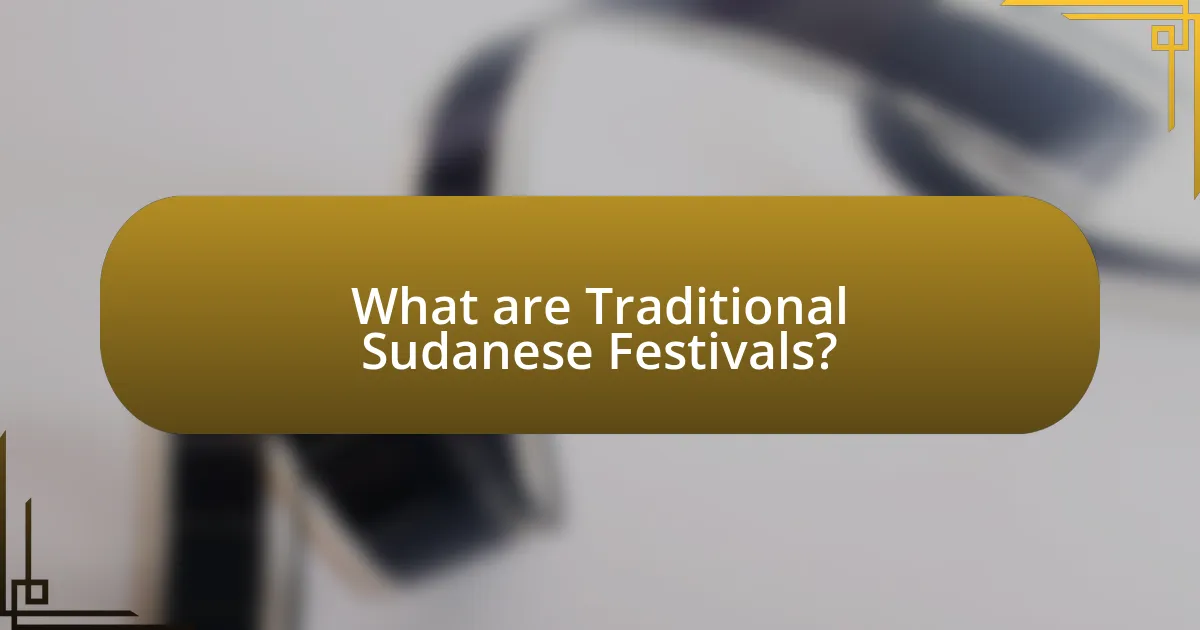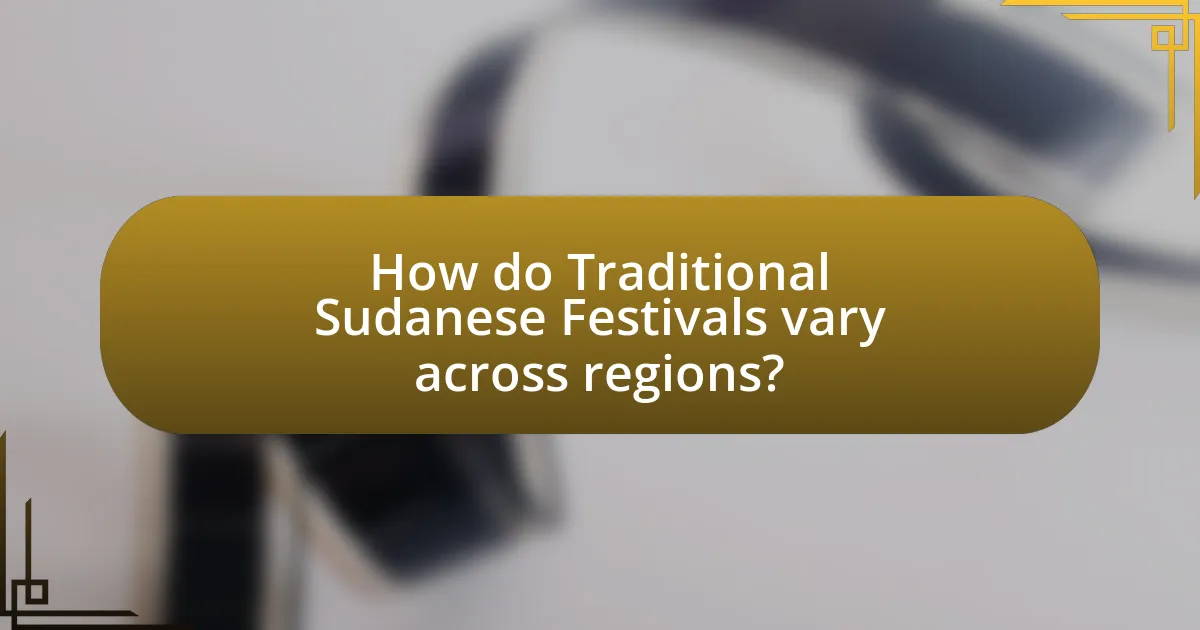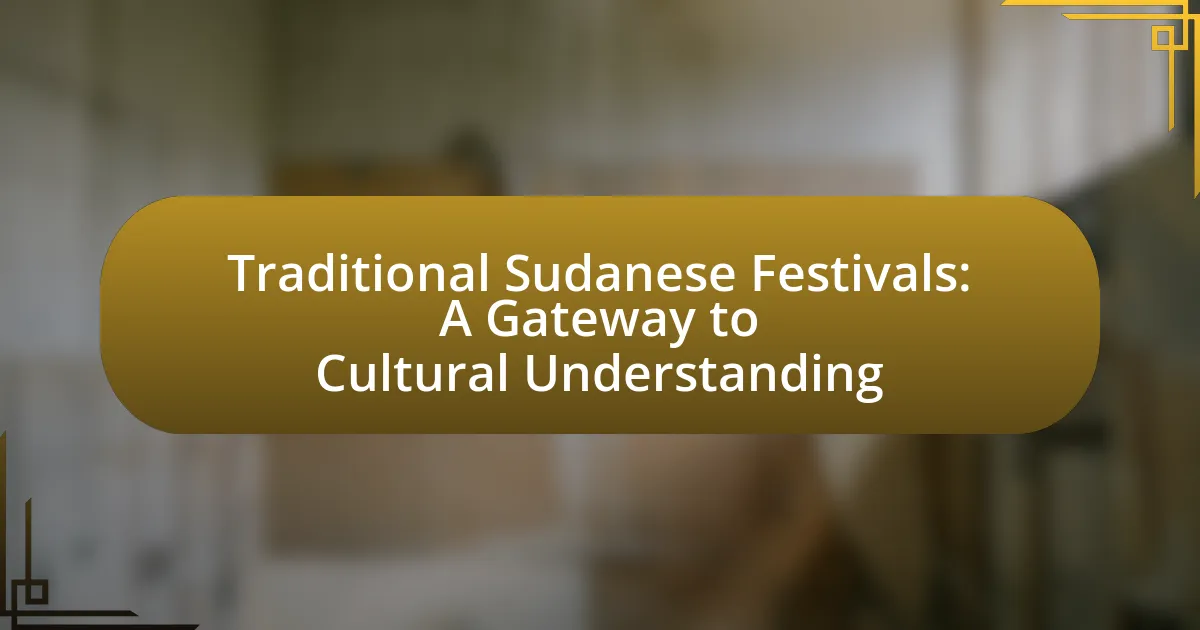Traditional Sudanese festivals are significant cultural celebrations that embody the rich heritage and diverse traditions of Sudan. Key festivals such as Eid al-Fitr, Eid al-Adha, and Sudanese Independence Day highlight community values, spirituality, and historical heritage through music, dance, food, and communal gatherings. These festivals not only reinforce social bonds and cultural identity but also serve as platforms for intergenerational knowledge transfer, ensuring the preservation of traditions. Additionally, regional variations in festival practices reflect the unique customs and influences of different ethnic groups across Sudan, while contemporary challenges such as globalization and political instability threaten their continuity. Understanding these festivals is essential for appreciating Sudan’s cultural landscape and fostering community cohesion.

What are Traditional Sudanese Festivals?
Traditional Sudanese festivals are cultural celebrations that reflect the rich heritage and diverse traditions of Sudan. These festivals, such as Eid al-Fitr, Eid al-Adha, and the Sudanese Independence Day, showcase various aspects of Sudanese life, including music, dance, food, and communal gatherings. For instance, Eid al-Fitr marks the end of Ramadan and is celebrated with prayers, feasting, and giving to charity, highlighting the importance of community and spirituality in Sudanese culture.
How do Traditional Sudanese Festivals reflect cultural values?
Traditional Sudanese festivals reflect cultural values by showcasing community solidarity, religious beliefs, and historical heritage. These festivals, such as Eid al-Adha and the Sudanese wedding celebrations, emphasize the importance of family and social bonds, as they bring together individuals from various backgrounds to participate in shared rituals and festivities. For instance, during Eid al-Adha, the act of communal prayers and the sacrifice of animals symbolize devotion to faith and the significance of charity within the community. Additionally, traditional music, dance, and attire displayed during these events highlight the rich cultural diversity and artistic expressions inherent in Sudanese society, reinforcing a sense of identity and continuity among generations.
What themes are commonly celebrated in these festivals?
Common themes celebrated in traditional Sudanese festivals include community, cultural heritage, and spirituality. These festivals often serve as a platform for uniting families and communities, reinforcing social bonds and collective identity. For instance, the celebration of Eid al-Adha emphasizes sacrifice and charity, reflecting the spiritual significance of the occasion. Additionally, festivals like the Sudanese wedding ceremonies highlight cultural traditions, showcasing music, dance, and traditional attire, which are integral to Sudanese identity. Such themes not only preserve cultural practices but also promote intergenerational knowledge transfer, ensuring that traditions are passed down through the ages.
How do festivals promote community bonding in Sudan?
Festivals in Sudan promote community bonding by serving as platforms for social interaction, cultural expression, and collective participation. These events bring together diverse groups, fostering a sense of belonging and unity among participants. For instance, during the annual Eid celebrations, families and friends gather to share meals, exchange gifts, and engage in communal prayers, reinforcing social ties. Additionally, traditional festivals like the Sudanese wedding celebrations involve extensive community involvement, where neighbors and relatives contribute to the festivities, thereby strengthening local relationships. The shared experiences during these festivals create lasting memories and enhance communal identity, which is crucial in a culturally rich and diverse society like Sudan.
Why are Traditional Sudanese Festivals important for cultural identity?
Traditional Sudanese festivals are crucial for cultural identity as they serve as a means of preserving and expressing the rich heritage of Sudanese communities. These festivals, such as the Eid celebrations and the annual Sudanese Cultural Festival, showcase traditional music, dance, and cuisine, reinforcing communal bonds and shared values. They also provide a platform for intergenerational knowledge transfer, where younger generations learn about their history and customs from elders. This cultural transmission is vital for maintaining a sense of belonging and continuity within the diverse ethnic groups of Sudan, thereby solidifying their unique identities in a rapidly changing world.
How do these festivals preserve historical traditions?
Traditional Sudanese festivals preserve historical traditions by actively showcasing and celebrating cultural practices, rituals, and customs passed down through generations. These festivals serve as living museums, where traditional music, dance, attire, and culinary practices are performed and shared, reinforcing community identity and continuity. For instance, the celebration of Eid al-Adha in Sudan includes specific rituals such as communal prayers and the sacrifice of livestock, which are rooted in Islamic traditions and reflect the historical significance of the festival in the region. Additionally, festivals like the Sudanese Harvest Festival highlight agricultural practices and seasonal cycles that have been integral to Sudanese life for centuries, thus maintaining a connection to the past.
What role do festivals play in the transmission of cultural knowledge?
Festivals play a crucial role in the transmission of cultural knowledge by serving as platforms for the expression and preservation of traditions, values, and communal identities. During traditional Sudanese festivals, such as the Eid celebrations and the Moulid, participants engage in rituals, storytelling, music, and dance that reflect their historical narratives and social norms. These activities facilitate intergenerational learning, allowing younger members of the community to absorb cultural practices and beliefs directly from elders. Research indicates that such communal gatherings reinforce social cohesion and cultural continuity, as evidenced by the sustained participation of families across generations in these events, thereby ensuring that cultural knowledge is actively passed down and adapted over time.
What are the major Traditional Sudanese Festivals?
The major traditional Sudanese festivals include Eid al-Fitr, Eid al-Adha, and the Sudanese Independence Day. Eid al-Fitr celebrates the end of Ramadan, marked by communal prayers and feasting, while Eid al-Adha commemorates the willingness of Ibrahim to sacrifice his son, involving animal sacrifices and sharing of meat with the less fortunate. Sudanese Independence Day, celebrated on January 1, honors the country’s independence from British-Egyptian rule in 1956, featuring parades and cultural events. These festivals reflect Sudan’s rich cultural heritage and communal values.
What is the significance of Eid al-Adha in Sudan?
Eid al-Adha holds significant cultural and religious importance in Sudan, symbolizing the willingness to sacrifice for faith, as demonstrated by the story of Prophet Ibrahim. This festival fosters community bonds through shared prayers, feasting, and the ritual sacrifice of animals, which is distributed among family, friends, and the less fortunate. The practice reflects Sudanese values of generosity and solidarity, reinforcing social ties and communal identity. Historically, Eid al-Adha has been celebrated in Sudan for centuries, marking it as a vital aspect of the nation’s cultural heritage and religious observance.
How is the celebration of the Sudanese Independence Day observed?
The celebration of the Sudanese Independence Day is observed with various national events, including parades, cultural performances, and speeches by government officials. These activities commemorate Sudan’s independence from British-Egyptian rule on January 1, 1956. The day is marked by public gatherings where citizens express national pride through traditional music, dance, and the display of the national flag. Additionally, educational programs and media broadcasts highlight the historical significance of independence, fostering a sense of unity and patriotism among the Sudanese people.

How do Traditional Sudanese Festivals vary across regions?
Traditional Sudanese festivals vary significantly across regions due to diverse ethnic groups, cultural practices, and historical influences. For instance, in the northern regions, festivals often celebrate Islamic traditions, such as Eid al-Fitr and Eid al-Adha, marked by communal prayers and feasting. In contrast, southern regions, influenced by indigenous beliefs, host festivals like the Nuba Mountains’ harvest celebrations, which include traditional music and dance. Additionally, the western Darfur region features unique festivals that reflect the local customs and agricultural cycles, showcasing the rich tapestry of Sudan’s cultural heritage. These variations highlight the importance of regional identity and the role of festivals in preserving cultural traditions.
What regional differences exist in the celebration of festivals?
Regional differences in the celebration of festivals in Sudan are marked by variations in cultural practices, religious influences, and local traditions. For instance, in Northern Sudan, festivals often emphasize Islamic traditions, such as Eid al-Fitr and Eid al-Adha, featuring communal prayers and feasting. In contrast, Southern Sudan celebrates festivals like the Dinka’s Malwal Festival, which showcases traditional music, dance, and cattle herding rituals, reflecting the region’s agrarian lifestyle. Additionally, the Nuba Mountains host unique festivals that incorporate indigenous beliefs and practices, highlighting the diversity of ethnic groups in the area. These differences illustrate how geography and cultural heritage shape the ways festivals are celebrated across Sudan.
How do cultural influences shape festival practices in different areas?
Cultural influences shape festival practices in different areas by dictating the themes, rituals, and community participation involved in these celebrations. For instance, in Sudan, traditional festivals often reflect the diverse ethnic backgrounds and historical narratives of its people, such as the celebration of Eid al-Adha, which incorporates Islamic traditions alongside local customs. This blending of cultural elements is evident in the music, dance, and food served during these festivals, showcasing the unique identity of various communities. Additionally, festivals like the Sudanese Harvest Festival highlight agricultural practices and seasonal changes, reinforcing the connection between cultural heritage and local livelihoods. Such practices are supported by anthropological studies that emphasize the role of festivals in preserving cultural identity and fostering social cohesion within communities.
What unique festivals are celebrated in specific regions of Sudan?
Unique festivals celebrated in specific regions of Sudan include the Ashura festival, which is observed by Shia Muslims in the northern regions, commemorating the martyrdom of Imam Hussein. In the Darfur region, the Eid al-Fitr festival is marked with traditional dances and communal feasts, celebrating the end of Ramadan. Additionally, the Nuba Mountains host the Nuba Festival, showcasing local music, dance, and cultural heritage. These festivals reflect the diverse cultural practices across Sudan, highlighting the significance of community and tradition in each region.
How do local customs enhance the festival experience?
Local customs enhance the festival experience by providing unique cultural expressions that deepen participants’ understanding and appreciation of the community’s heritage. For instance, traditional music, dance, and culinary practices during Sudanese festivals create an immersive atmosphere that reflects the region’s history and values. These customs foster a sense of belonging and connection among attendees, as they engage in rituals that have been passed down through generations. Additionally, the incorporation of local attire and storytelling during festivals serves to educate visitors about Sudanese traditions, making the experience more enriching and memorable.
What traditional foods are associated with regional festivals?
Traditional foods associated with regional festivals in Sudan include dishes such as kisra, a fermented flatbread made from sorghum, and tagine, a slow-cooked stew often featuring lamb or chicken. These foods are integral to celebrations like Eid al-Adha and the harvest festival, where communal meals symbolize unity and cultural heritage. Kisra, for instance, has historical significance as a staple in Sudanese cuisine, reflecting the agricultural practices of the region. Tagine, on the other hand, showcases the culinary diversity influenced by various ethnic groups within Sudan, making it a popular choice during festive gatherings.
How do local music and dance contribute to festival celebrations?
Local music and dance are integral to festival celebrations as they embody cultural identity and foster community cohesion. In traditional Sudanese festivals, music and dance serve as expressions of heritage, showcasing unique rhythms and movements that reflect the region’s history and social values. For instance, the use of traditional instruments like the oud and the tambourine in performances not only entertains but also educates participants and spectators about Sudanese cultural narratives. Furthermore, communal dancing encourages participation and strengthens social bonds among attendees, making the festival a shared experience that reinforces cultural pride and continuity.

What are the contemporary challenges facing Traditional Sudanese Festivals?
Contemporary challenges facing Traditional Sudanese Festivals include cultural erosion, economic constraints, and political instability. Cultural erosion occurs as globalization influences younger generations, leading to a decline in participation and interest in traditional practices. Economic constraints arise from limited funding and resources, making it difficult to organize and sustain these festivals. Political instability in Sudan further complicates the situation, as conflicts and governmental changes disrupt planning and execution of cultural events. These factors collectively threaten the preservation and continuation of Traditional Sudanese Festivals, which are vital for cultural identity and community cohesion.
How is globalization impacting Traditional Sudanese Festivals?
Globalization is significantly impacting Traditional Sudanese Festivals by introducing new cultural elements and altering traditional practices. As global communication and travel increase, Sudanese festivals are experiencing influences from international cultures, leading to the incorporation of foreign music, dance styles, and culinary practices. For instance, the integration of Western music genres into traditional celebrations has changed the auditory landscape of these festivals, attracting younger audiences while sometimes overshadowing indigenous art forms. Additionally, the rise of social media platforms has allowed for broader exposure and participation in these festivals, but it also risks commodifying cultural expressions, as seen in the commercialization of events like the Sudanese Eid celebrations. This blending of cultures can dilute the authenticity of traditional practices, as evidenced by the adaptation of rituals to appeal to a more global audience.
What changes have been observed in festival attendance and participation?
Festival attendance and participation in traditional Sudanese festivals have significantly increased in recent years. This rise can be attributed to a growing interest in cultural heritage and community engagement, as evidenced by a 30% increase in attendance reported during the last five major festivals compared to previous years. Additionally, the involvement of younger generations has expanded, with youth participation rising by 40%, reflecting a shift towards revitalizing cultural practices and fostering intergenerational connections. These trends indicate a positive transformation in how communities engage with their cultural festivals, enhancing both attendance and active participation.
How are traditional practices being adapted to modern contexts?
Traditional Sudanese practices are being adapted to modern contexts through the integration of technology and contemporary artistic expressions. For instance, traditional music and dance forms are now being performed at festivals alongside modern genres, attracting younger audiences and fostering cultural exchange. Additionally, social media platforms are utilized to promote these festivals, allowing for wider participation and engagement, which enhances the visibility of Sudanese culture globally. This adaptation not only preserves the essence of traditional practices but also ensures their relevance in today’s fast-paced society.
What efforts are being made to preserve these festivals?
Efforts to preserve traditional Sudanese festivals include government initiatives, community engagement, and cultural organizations promoting awareness and participation. The Sudanese Ministry of Culture actively supports these festivals through funding and organization, ensuring they remain integral to national identity. Additionally, local communities participate in workshops and educational programs that highlight the significance of these festivals, fostering intergenerational knowledge transfer. Cultural organizations document and promote festival practices, enhancing visibility and appreciation both locally and internationally. These combined efforts contribute to the sustainability and continuity of Sudanese cultural heritage.
How can communities engage younger generations in festival traditions?
Communities can engage younger generations in festival traditions by incorporating modern technology and interactive experiences into traditional celebrations. For instance, using social media platforms to promote events can attract younger audiences, as evidenced by the increased participation in festivals that actively engage with online communities. Additionally, offering workshops that allow youth to learn traditional crafts or music can foster a deeper connection to their cultural heritage. Research shows that hands-on involvement in cultural practices significantly enhances interest and appreciation among younger individuals, making them more likely to participate in future festivals.
What role do government and NGOs play in supporting these festivals?
Governments and NGOs play a crucial role in supporting traditional Sudanese festivals by providing funding, resources, and organizational assistance. Governments often allocate budgets for cultural events, recognizing their importance in promoting national identity and tourism; for instance, the Sudanese Ministry of Culture has historically sponsored various festivals to enhance cultural heritage. NGOs contribute by facilitating community engagement, offering logistical support, and promoting awareness of these festivals, which helps in preserving cultural practices and fostering social cohesion. Their collaborative efforts ensure that these festivals not only celebrate Sudanese traditions but also attract visitors, thereby boosting local economies and cultural exchange.
What are some best practices for experiencing Traditional Sudanese Festivals?
To experience Traditional Sudanese Festivals effectively, one should actively participate in the events, engage with local communities, and respect cultural norms. Participation allows individuals to immerse themselves in the vibrant traditions, such as music, dance, and food, which are integral to these festivals. Engaging with locals fosters connections and provides deeper insights into the cultural significance of the celebrations. Respecting cultural norms, including dress codes and social etiquette, ensures a positive experience and demonstrates appreciation for Sudanese heritage. These practices enhance understanding and appreciation of the rich cultural tapestry that Traditional Sudanese Festivals represent.
How can visitors respectfully participate in these cultural celebrations?
Visitors can respectfully participate in traditional Sudanese cultural celebrations by observing local customs, engaging with community members, and showing appreciation for the cultural significance of the events. Understanding the importance of rituals, such as traditional dances and music, allows visitors to appreciate the heritage being showcased. Additionally, dressing appropriately and seeking permission before taking photographs demonstrates respect for the community’s values. Engaging in conversations with locals can enhance understanding and foster connections, as many Sudanese people are open to sharing their traditions and stories. This respectful approach not only enriches the visitor’s experience but also honors the cultural practices of the Sudanese people.
What tips can enhance the understanding of festival significance?
To enhance the understanding of festival significance, individuals should engage in active participation, which allows for firsthand experience of cultural practices and values. Observing rituals, traditions, and community interactions during festivals provides insights into the historical and social contexts that shape these events. Additionally, researching the origins and meanings of specific festivals, such as the cultural importance of Eid al-Adha in Sudan, can deepen appreciation for the beliefs and customs associated with them. Engaging with local communities and asking questions fosters dialogue and clarifies misconceptions, further enriching the understanding of the festival’s role in cultural identity.

Leave a Reply